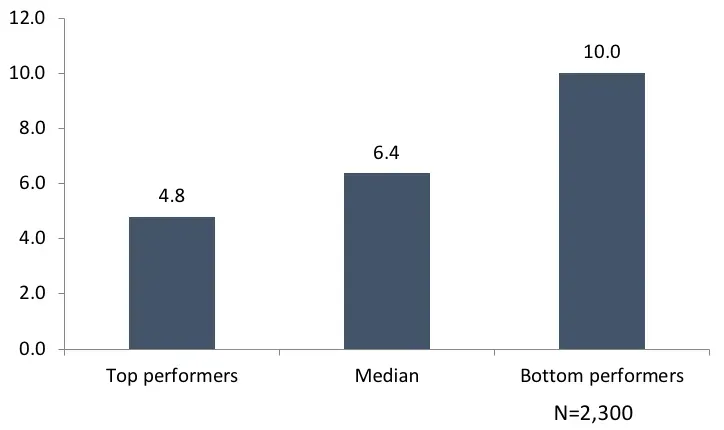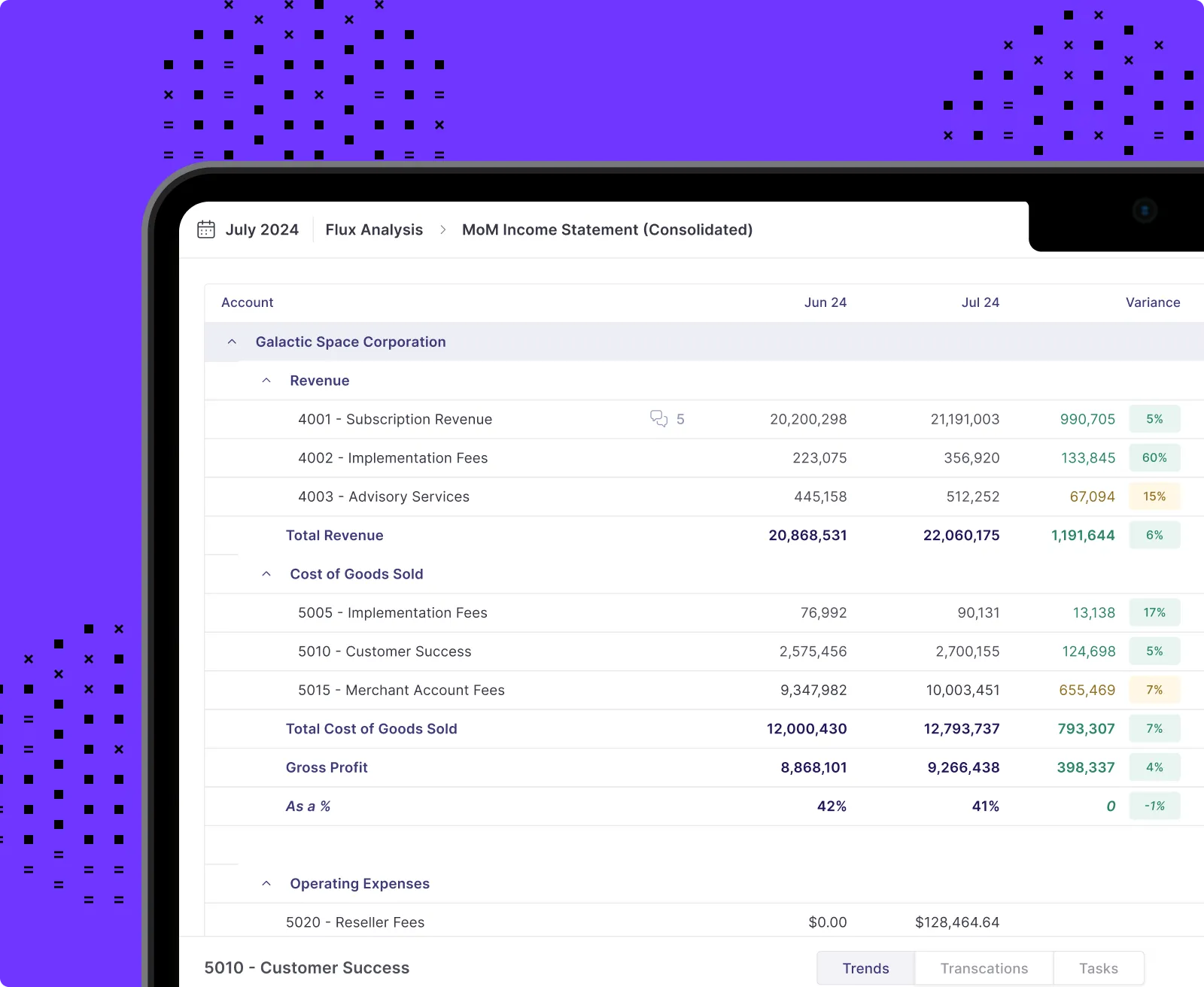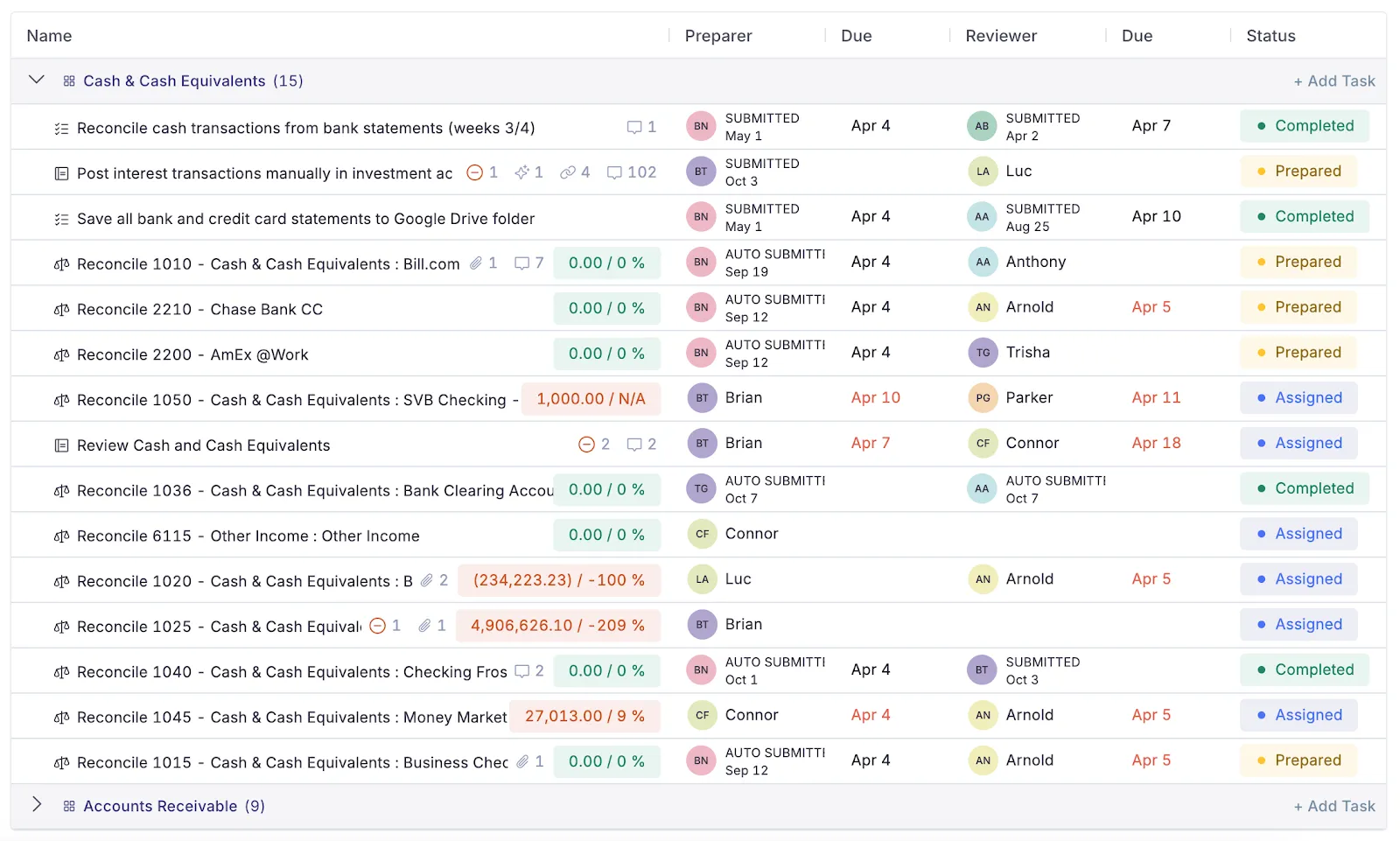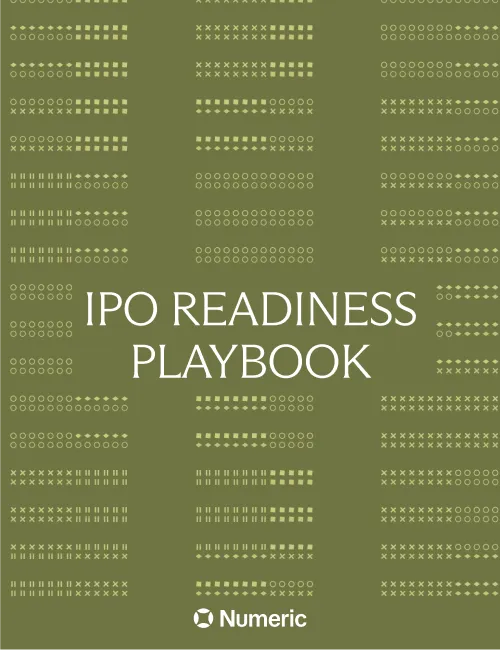Balancing the Books: Numeric’s Month End Close Primer
.webp)
Asking accountants what goes on during the month-end is like asking a mechanic to explain how cars work: frankly, where does one begin?
And considering that the month-end looks different for every single company out there, you’re almost better off asking accountants what isn’t included in the month end close process than what is.
That said, we’ve taken the time to parse out the nice-to-know from the need-to-know of the month end, and below, we’ve put together an outline of some key steps and best practices for anyone trying to get a relatively high-level understanding of how the month-end close works.
Already know the basics and want an expert level view of month end processes? Check out our comprehensive e-book: Mastering the Month-End Close, which compiles tips from leading Controllers.
What is the Month End Close?
The month-end close is a structured process that companies use to wrap up their financial activities by the end of each month. It’s a way to close the books and provide an up-to-date picture of the company’s financial performance from the previous month to inform decisions for the next month.
Several key activities make up the monthly closing process: inputting financial data, reconciling accounts, reviewing transactions, and preparing monthly financial statements.
Each of these steps helps in creating a clear and accurate picture of your financial standing, which is essential for strategic planning and operational efficiency.
But what actually happens during month end?
That depends. Take, for example, three common accounting procedures — revenue recognition, fixed asset depreciation, and software capitalization. In the most ideal close, teams would accomplish all of these tasks but that’s rarely the case. Similarly, while textbooks might say that teams should account for every single transaction in a month, that’s also far from reality.
So, what is the true scope of the month-end close you ask? We would say this:
The month-end close process delivers your team accurate and actionable financial data from the preceding month to inform business decisions and adhere to control requirements.
How Long Does the Month End Close Take?
Stop me if you’ve heard this already: it depends.
To give some context, publications often cite The American Productivity and Quality Center's (APQC) 2017 General Accounting Open Standards Benchmarking survey as a benchmark for month-end close cycles.
APQC measured the "Cycle Time to Monthly Close" — defined as the cycle time in calendar days between running the trial balance to completing the consolidated financial statements— in 2,300 organizations. The study cited six calendar days as the median Cycle Time to Monthly Close, which given the large sample size is fairly credible.

However, it’s worth noting that the study is now almost seven years old and largely happened before the AI & automation wave hit finance.
Why is the Month End Close Essential?
It’s simple: finance teams need accurate, actionable data to satisfy their stakeholders, and the month-end close represents a means to that end. CFO and management? They need strong data to understand company performance. Auditors? Strong data can be proof of compliant, controlled accounting processes. No matter the party, as long as they connect to the accounting department, the month-end close is foundational to their success.
These five use cases explain why the month end matters for finance teams:
Facilitating Informed Decisions: When management has access to precise financial information, they can assess the company’s performance and identify areas for improvement. This data drives effective decision-making, whether it’s related to budgeting, investment, or resource allocation.
Foundation for Strategic Planning: Without a reliable financial foundation, strategic planning becomes guesswork. With clear and accurate financial records, businesses can forecast future performance and plan accordingly.
Enhancing Financial Visibility: Stakeholders, such as investors and creditors, expect transparency in financial reporting. Accurate monthly reports not only help maintain trust and credibility with these stakeholders, but they also provide a clear view of the company’s financial health.
Auditing Ease: By ensuring that all financial data is accurate and up to date, businesses make it easier for auditors to verify their records. This reduces the time and effort required during audits, which can be both time-consuming and expensive.
Ensuring Compliance: Companies must adhere to standards set by governing bodies, like Generally Accepted Accounting Principles (GAAP) or International Financial Reporting Standards (IFRS). Regular closing procedures help ensure that financial reports are prepared according to these guidelines.

Executing the Month-End Close Process
While the month-end close process differs greatly from company to company, some procedures — like AP recs and AR recs, for example — remain universal. Here’s a breakdown of the components integral to nearly every company’s close.

Step 1: Collect Financial Information
Start by gathering financial transactions for the month. At a high level, this will include:
- General Ledger: It almost goes without saying — we can’t get the party started without GL data. Because Numeric integrates directly with your ERP, the trial balance and supporting document total for each account will auto-populate each month, no need to download.
- Bank Statements: These come directly from your bank accounts and are necessary for understanding incoming cash.
- A/R Aging Report: If you’re sending invoices through accounting software like Quickbooks, NetSuite, etc., you’ll tie your A/R TB directly to the total of unpaid custom billings in your A/R Aging report.
- A/P Aging Report: This report summarizes the bills and invoices owed by your business, broken down by vendor and due date.
- Vendor Invoices: These documents will state the types, quantities, payment terms, and agreed prices for products or services from your suppliers.
- Customer Billings: These will usually come from your payment system (i.e. Stripe).
- Workpapers: If your team keeps workpapers for certain accounts like prepaids or fixed assets, keep those handy for the account reconciliation process.
Step 2: Depreciation, Amortization, and Capitalization Evaluation
It’s necessary to properly assess depreciation for items like fixed assets and to amortize capitalized expenses as they each affect your balance sheet and taxable income.
- Amortization Evaluation: See which purchases in the month should be capitalized, and have their cost amortized over a set period of time.
- Depreciation Evaluation: Review assets such as equipment and vehicles for depreciation.
Step 3: Reconcile Accounts
One could argue that reconciliation is the most fundamental part of the close as it's the most directly tied to understanding a company’s finances.
Here, the goal is to ensure that totals from your general ledger tie out with the totals from your supporting documents. When moving towards a more sophisticated close process, often teams start reconciling the accounts that are most important for their businesses and then expand over time.

Reconciling Cash Accounts
Bank reconciliation, or cash account recs, at month-end typically involves matching the bank statement with the company’s general ledger account balance, identifying discrepancies and making necessary adjustments.
Since Numeric can automatically pull a company’s trial balance from the GL and totals from bank statements, teams automate much of the reconciliation process and can auto-submit recons that are below the materiality threshold.
Reconciling Non-Cash Accounts
Reconciliation for other GL accounts takes three steps:
- Compare Totals: If the totals in your workpapers/spreadsheets/etc. tie out with the GL, then you can assume that the corresponding account is balanced. If not, you’ll have to look for any mismatches between the ledger entries and the supporting sources.
- Investigate Differences: Clarify any discrepancies in the account — is there a procedural error? Were journal entries recorded incorrectly? Did a vendor/customer potentially make a mistake?
- Make Adjustments to the GL: Adjust the GL by adding, removing, or correcting entries. Ensure that the updated entries reflect accurate balances.
Step 4: Prepare Financial Statements
Once data is verified, prepare key financial documents:
- Balance Sheet: Reflect the company’s assets, liabilities, and equity at the end of the accounting period.
- Income Statement: Summarize revenues and expenses, showing profit or loss over the month.
- Cash Flow Report: Detail the cash inflows and outflows, crucial for understanding liquidity and operational efficiency.
Step 5: Conduct a Final Review
A final check ensures completeness and accuracy — here are some example questions to guide the last review of the close:
- Have all transactions and journal entries been coded to the right accounts?
- Have all prepaid expenses/accruals/fixed assets been properly accounted for?
- Do all the key accounts on the balance sheet tie out or have a variance below the materiality threshold?
By following these steps, the month-end close process becomes a structured routine that enhances financial clarity and organizational efficiency.
Step 6: Post-Close Flux Analysis
Flux analysis can happen both during and after the close, depending on a company’s needs.
For teams that are looking to further verify their data, then variance analysis will actually take place during the close. For those trying to extract insights from company financials, then flux will generally sit as a post-close activity.
What is a Month-End Closing Checklist?
A month-end closing checklist serves as a structured guide to ensure all necessary financial tasks are completed accurately and efficiently. A well-designed month-end closing checklist acts as a roadmap for accounting teams, helping them navigate complex financial workflows with clarity and precision.
Want to get a head start on building your close checklist? Use one of our industry-specific checklist templates — retail, SaaS, manufacturing, real estate, and more.
Why Do I Need A Close Checklist?
Denise Sterling, financial controller at Sourcegraph, swears by her team’s checklist, saying that it helps “to track when something is done and who’s doing it, so you can keep on top of everything.”
She adds:
“I have instilled in my team that updating the close checklist is super important. I love going into the checklist and seeing everybody in there — like it's always open on their desktop, and they're actively marking things off. Our team knows where we stand.”
In short, a close checklist works to streamline the close process, helping teams to budget time, set mid-close deadlines, and remain accountable for all close tasks.
Common Checklist Categories & Tasks
Close checklists are often organized by functional areas, which are typically roughly aligned with financial statement line item and balance sheet account groupings. Tasks can be broken down by who’s doing what as well.
Teams tend to group their checklist tasks into one of the following categories —
- Cash & Cash Equivalents
- Prepaids & Other Assets
- Revenue & Deferred Revenue
- Accruals & Other Liabilities
- Accounts Receivable
- Accounts Payable
- Expense Accounts
- OpEx
- Payroll & Benefits
- Fixed Assets
- Investments
- Debt
- Equity
- Financial Reporting
- Tax
- Budgeting
- Customer Metrics
Here’s an example of a task list setup in Numeric for the Cash & Cash Equivalents account groups — in addition to a series of account reconciliations listed as tasks, we see more team-specific tasks listed out like “Save all bank and credit card statements to Google Drive folder.”

Best Practices for Achieving a Quicker Close
Streamlining the month-end close process is crucial for improving efficiency and accuracy. Here are some strategies to enhance your financial closing operations:
Prioritize Accuracy over Speed (to start)
When thinking about striking a balance between accuracy and speed, Edwine Alphonse, Controller at Ramp, says, “Accuracy decreases the number of material adjustments that you have to do after the close.” However, she also adds:
“I ask the company to communicate their top priorities to me… where should the main focus of our reporting be? What will require the greatest degree of accuracy?”
Achieving the right level of detail and accuracy helps to identify issues, fix processes, and ultimately cut down on the time to close. However, teams must balance a desire for accuracy with a focus on prioritizing the data that’s required to inform business decisions. In doing so, it’s easier to identify which parts of the close need to be most accurate.
Move Tasks to the Pre-Close Period
The most efficient accounting teams don’t try to cram every close task into the close period. Instead, for things like payroll that can be accounted for in advance, they accomplish these tasks pre-close. For even more real-time accounting, teams can implement monitors for policy adherence/ accuracy checks; this way, when you enter the month-end close, you already have some degree of accuracy in your underlying data.
Centralize Data
Implement a centralized data repository. This ensures easy access to financial documents, reducing time spent searching for scattered information.
Use Templates and Checklists
You don’t have to build processes from scratch — instead, start with templates whenever applicable. Numeric’s library of templates includes useful examples like an accruals workpaper, an AR recs template, a SaaS close checklist, and much more.
Automate Processes
Tasks like data entry, reconciliation, and reporting benefit greatly from automation tools, allowing your team to focus on more strategic activities.
Train Staff Consistently
Educate team members about the closing process while also encouraging them to learn from each cycle. Share insights and tips within the team to foster a culture of ongoing improvement. Regular training sessions ensure everyone is on the same page and can adapt to any process changes or new software tools.
Implementing these best practices helps streamline the month-end close process, making it more efficient and accurate. This allows your business to focus on strategic goals and decision-making with confidence.
Numeric: Best Close Software for Modern Teams
If you’re getting a little woozy thinking about how to stay on top of all these month-end tasks or you’re already struggling to keep up, then it makes sense to invest in a financial close tool.
Across the internet, people are raving about how Numeric has helped to evolve their month end closing processes, and a number of features have clearly differentiated it from legacy tools in the space:
- Stay organized and audit-ready with clear controls and documentation: Numeric makes it easy to assign close tasks to preparers and reviewers, and keeps track of all comments, changes, and submissions in a clear month-end close checklist. When audit time rolls around, auditors can log straight into Numeric and see a complete activity trail, no need for your team to spend hours resurfacing required documentation.
- Automate your reconciliations: With Numeric, you can handle all your month-end GL recs in one spot. The system automatically pulls account totals from workpapers and your GL's trial balance. Even better, with a deep ERP integration, Numeric users can click into underlying transactions across accounts to investigate. Numeric also monitors prior period balances, flagging any changes since your last reconciliation.
- Set-up ongoing transaction monitoring: With Monitors, you can flexibly set-up ongoing alerts to catch errors ahead of month-end account reconciliations. Catch any transactions tied to particular customers or, for Controllers doing a quality check of the full month-end process, surface all journal entries booked to A/R to scan through.
- Maintain full-team visibility & clarity: Stay updated on close happenings with dedicated notifications, comment functionality, and Slack updates, ensuring a smooth flow of communication. To boost productivity, establish dependencies that lock certain tasks from being started until a preceding one is finished.
Frequently Asked Questions
What can I save for the quarter close instead of the month end close?
For the quarter close, you can save tasks that aren't time-sensitive or don’t inform immediate business decisions. Examples include stock-based compensation and (for smaller companies) asset depreciation.
By saving these for the quarter close, you focus on essential, frequent tasks at month-end and tackle lower-priority items quarterly. More details can be found in our guide to the month-end vs. quarter close.
The Bottom Line
To reference our early automotive analogy, while every car might run a little differently, they all perform best with proactive care and maintenance. In the same way, a good month end close requires teams to iron out processes, implement checklists, and leverage automation in order to get top-notch closing times.
Like a well-oiled engine, a solid month-end close keeps your finances running smoothly and your business in the fast lane.

















.png)
.png)
.png)